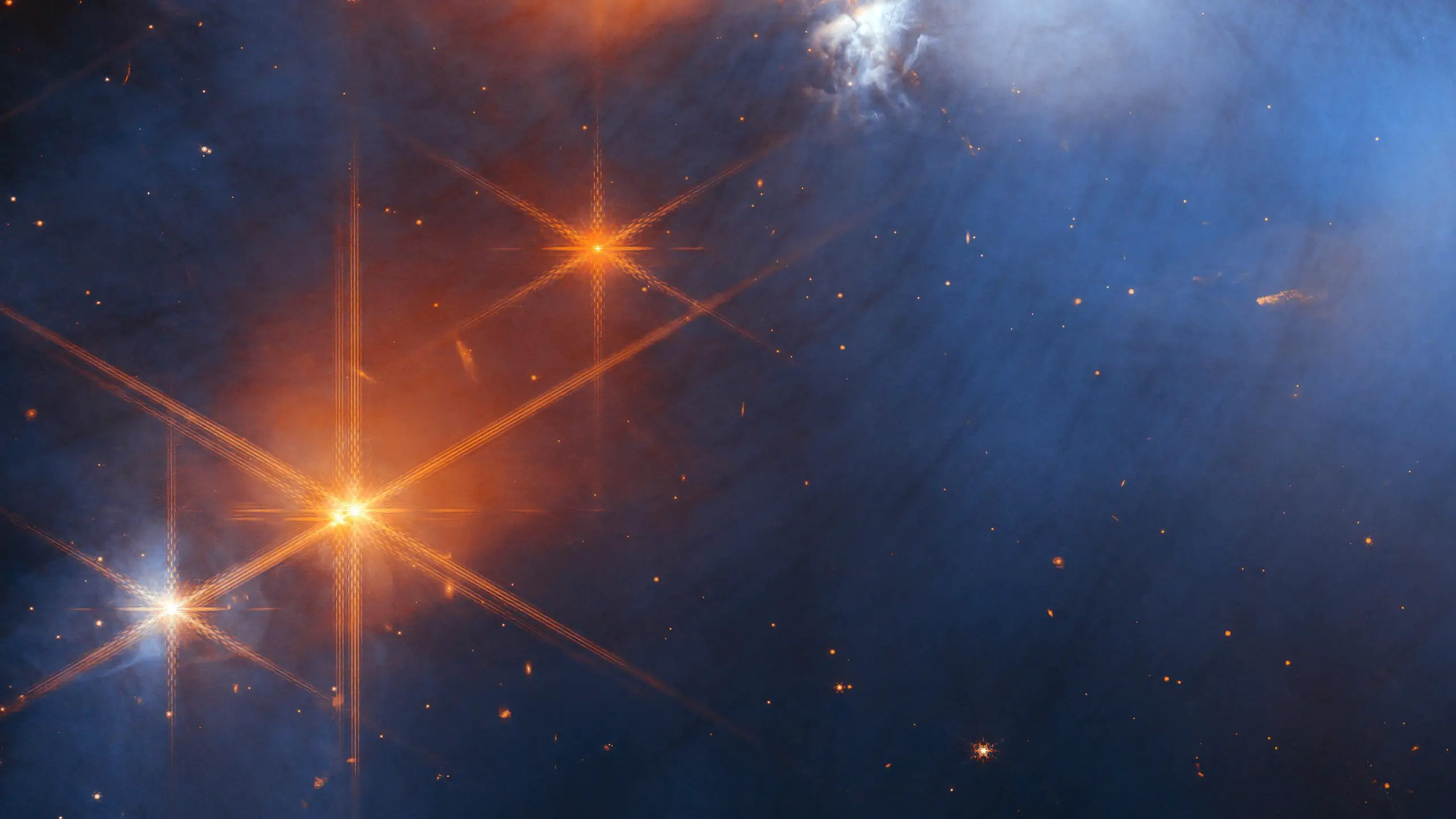
Un equipo internacional de astrónomos ha informado del descubrimiento de diversos hielos en las regiones más oscuras de una nube molecular fría medida hasta ahora mediante el estudio de esta región. El hallazgo permite a los astrónomos examinar partículas heladas simples que se incorporarán a futuros exoplanetas, al tiempo que abre una nueva ventana sobre el origen de partículas más complejas que son el primer paso para crear los componentes básicos de la vida. Crédito: Imagen: NASA, ESA, CSA, Ciencia: Fengwu Sun (Observatorio Steward), Zak Smith (The Open University), Equipo IceAge ERS, Procesamiento de imágenes: M. Zamani (ESA/Webb)
Webb identificó formas inmovilizadas de una amplia gama de moléculas, incluidos dióxido de carbono, amoníaco y metano.
Un equipo internacional de astrónomos anunció usando[{» attribute=»»>NASA’s James Webb Space Telescope. This result allows astronomers to examine the simple icy molecules that will be incorporated into future exoplanets, while opening a new window on the origin of more complex molecules that are the first step in the creation of the building blocks of life.

This image by NASA’s James Webb Space Telescope’s Near-Infrared Camera (NIRCam) features the central region of the Chamaeleon I dark molecular cloud, which resides 630 light years away. The cold, wispy cloud material (blue, center) is illuminated in the infrared by the glow of the young, outflowing protostar Ced 110 IRS 4 (orange, upper left). The light from numerous background stars, seen as orange dots behind the cloud, can be used to detect ices in the cloud, which absorb the starlight passing through them. Credit: Image: NASA, ESA, CSA, Science: Fengwu Sun (Steward Observatory), Zak Smith (The Open University), IceAge ERS Team, Image Processing: M. Zamani (ESA/Webb)
James Webb Space Telescope Unveils Dark Side of Pre-stellar Ice Chemistry
If you want to build a habitable planet, ices are a vital ingredient because they are the main source of several key elements — namely carbon, hydrogen, oxygen, nitrogen, and sulfur (referred to here as CHONS). These elements are important ingredients in both planetary atmospheres and molecules like sugars, alcohols, and simple amino acids.
An international team of astronomers using NASA’s James Webb Space Telescope has obtained an in-depth inventory of the deepest, coldest ices measured to date in a molecular cloud.[1] Además del hielo simple como el agua, el equipo pudo identificar formas congeladas de una amplia gama de moléculas, desde sulfuro de carbonilo, amoníaco y metano, hasta la molécula orgánica compleja más simple, el metanol. (Los investigadores consideraron que las moléculas orgánicas son complejas cuando hay seis o más átomos presentes). Este es el censo más completo hasta la fecha de los ingredientes helados disponibles para formar futuras generaciones de estrellas y planetas, antes de que se calentaran durante la formación de estrellas jóvenes.
dijo Melissa McClure, astrónoma del Observatorio de Leiden en los Países Bajos, investigadora principal del programa de observación y autora principal del artículo que describe el hallazgo. «Estas observaciones abren una nueva ventana sobre las vías de formación de las moléculas simples y complejas necesarias para fabricar los componentes básicos de la vida».

Versión comentada de la imagen de arriba. Las dos estrellas de fondo utilizadas en este estudio, NIR38 y J110621, se indican en la imagen en blanco. Crédito: NASA, ESA, CSA y M. Zamani (ESA/Webb); Ciencia: F. Sun (Stward Observatory), Z. Smith (Open University) y el equipo de Ice Age ERS
Además de las moléculas que identificaron, el equipo encontró evidencia de moléculas más complejas que el metanol y, aunque no han atribuido definitivamente estas señales a moléculas específicas, esto prueba por primera vez que las moléculas complejas se forman en las profundidades heladas de las nubes moleculares. antes de que nazcan las estrellas. .
agregó Will Rocha, un astrónomo del Observatorio de Leiden que contribuyó al descubrimiento. «Esto podría significar que la presencia de moléculas precursoras de prebióticos en los sistemas planetarios es una consecuencia común de la formación de estrellas, en lugar de una característica única de nuestro sistema solar».
Mediante la detección de sulfuros de carbonilo helados que contienen azufre, los investigadores han podido estimar por primera vez la cantidad de azufre presente en los granos de polvo preestelares helados. Si bien la cantidad medida es mayor que la observada anteriormente, aún es menor que la cantidad total que se esperaría que estuviera presente en esta nube, en función de su densidad. Esto también es cierto para otros CHONS. El principal desafío para los astrónomos es comprender dónde se esconden estos elementos: en hielo, material similar al hollín o rocas. La cantidad de CHONS en cada tipo de material determina cuánto de estos artículos terminan siendo procesados[{» attribute=»»>exoplanet atmospheres and how much in their interiors.
“The fact that we haven’t seen all of the CHONS that we expect may indicate that they are locked up in more rocky or sooty materials that we cannot measure,” explained McClure. “This could allow a greater diversity in the bulk composition of terrestrial planets.

Astronomers have taken an inventory of the most deeply embedded ices in a cold molecular cloud to date. They used light from a background star, named NIR38, to illuminate the dark cloud called Chamaeleon I. Ices within the cloud absorbed certain wavelengths of infrared light, leaving spectral fingerprints called absorption lines. These lines indicate which substances are present within the molecular cloud.
These graphs show spectral data from three of the James Webb Space Telescope’s instruments. In addition to simple ices like water, the science team was able to identify frozen forms of a wide range of molecules, from carbon dioxide, ammonia, and methane, to the simplest complex organic molecule, methanol.
In addition to the identified molecules, the team found evidence for molecules more complex than methanol (indicated in the lower-right panel). Although they didn’t definitively attribute these signals to specific molecules, this proves for the first time that complex molecules form in the icy depths of molecular clouds before stars are born.
The upper panels and lower-left panel all show the background star’s brightness versus wavelength. A lower brightness indicates absorption by ices and other materials in the molecular cloud. The lower-right panel displays the optical depth, which is essentially a logarithmic measure of how much light from the background star gets absorbed by the ices in the cloud. It is used to highlight weaker spectral features of less abundant varieties of ice.
Credit: Illustration: NASA, ESA, CSA, Joseph Olmsted (STScI), Science: Klaus Pontoppidan (STScI), Nicolas M. Crouzet (LEI), Zak Smith (The Open University), Melissa McClure (Leiden Observatory)
Chemical characterization of the ices was accomplished by studying how starlight from beyond the molecular cloud was absorbed by icy molecules within the cloud at specific infrared wavelengths visible to Webb. This process leaves behind chemical fingerprints known as absorption lines which can be compared with laboratory data to identify which ices are present in the molecular cloud. In this study, the team targeted ices buried in a particularly cold, dense, and difficult-to-investigate region of the Chamaeleon I molecular cloud, a region roughly 500 light-years from Earth that is currently in the process of forming dozens of young stars.
“We simply couldn’t have observed these ices without Webb,” elaborated Klaus Pontoppidan, Webb project scientist at the Space Telescope Science Institute in Baltimore, Maryland, who was involved in this research. “The ices show up as dips against a continuum of background starlight. In regions that are this cold and dense, much of the light from the background star is blocked, and Webb’s exquisite sensitivity was necessary to detect the starlight and therefore identify the ices in the molecular cloud.”
Esta investigación es parte de proyecto edad de hielo, uno de los 13 programas de lanzamiento anticipado de Webb. Estas observaciones están diseñadas para mostrar las capacidades de observación de Webb y permitir que la comunidad astronómica aprenda a sacar el máximo partido de sus instrumentos. El equipo de Ice Age ya ha planeado más observaciones y espera rastrear el viaje del hielo desde su formación hasta la reunión de cometas helados.
«Esta es solo la primera vez en una serie de instantáneas espectrales que veremos cómo evolucionan los hielos desde su composición inicial hasta las regiones de formación de cometas de los discos protoplanetarios», concluyó McClure. «Esto nos dirá qué mezcla de hielos, y por lo tanto qué elementos, podrían finalmente llegar a las superficies de exoplanetas terrestres o incorporarse a las atmósferas de gigantes gaseosos o planetas helados».
Estos resultados fueron publicados en la edición del 23 de enero de astronomía natural.
notas
- Una nube molecular es una enorme nube interestelar de gas y polvo en la que se pueden formar moléculas, como hidrógeno y monóxido de carbono. Grupos fríos y densos en nubes moleculares con densidades más altas que sus alrededores podrían ser sitios de formación de estrellas si colapsan para formar protoestrellas.
Referencia: «Ice Age JWST Inventory of Dense Molecular Cloud Snow» por M.K. McClure, D. . Qasim, MJ Rasheed, ZL Smith, Fengo Sun, Tracy L. Beck, ACA Bogert, W. Brown, B. Caselli, S.B. Charnley, Herma M. Cobbin, H. Dickinson, M.N. Drozdovskaya, Egami, J. Erkal, H. Fraser, RT Garrod, DeHarsono, S. Iopoulou, I Jimenez-Serra, MJin, JK Jorgensen, Lee Christensen, DC Lees, MRS McCostra, Brett A McGuire, JG Melnick, Karen I Oberg, May Palumbo, T. Shimonishi, J.A. Storm , EF Van Dishoek y H. Lennarts, 23 de enero de 2023, disponible aquí. astronomía natural.
DOI: 10.1038/s41550-022-01875-w
El telescopio espacial James Webb es el principal observatorio de ciencia espacial del mundo. Webb resolverá misterios en nuestro sistema solar, mirará más allá de mundos distantes alrededor de otras estrellas e investigará estructuras misteriosas y los orígenes del universo y nuestro lugar en él. Webb es un programa internacional liderado por la NASA con sus socios ESA (Agencia Espacial Europea) y la Agencia Espacial Canadiense.

«Web friki. Wannabe pensador. Lector. Evangelista de viajes independiente. Aficionado a la cultura pop. Erudito musical certificado».






